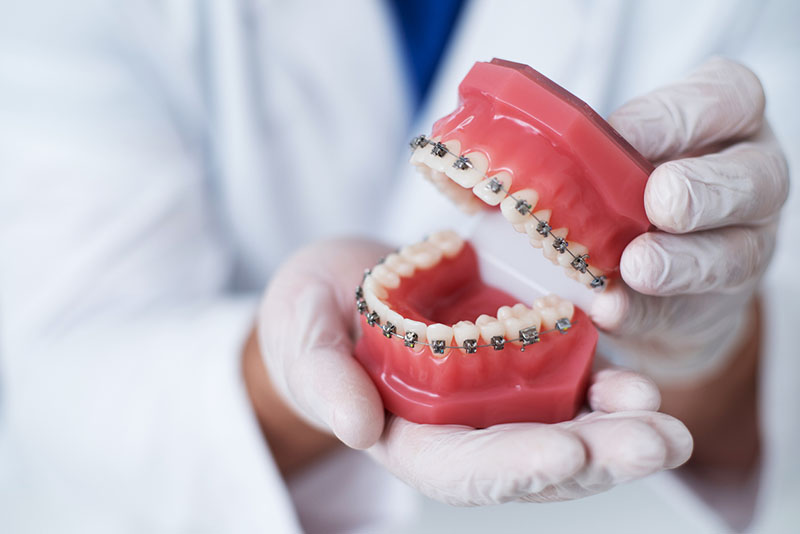An orthodontist isn’t a fancy word for a dentist but rather a special form of dentistry. While dentistry does deal with the general irregularities around the mouth and jaw, orthodontics focuses on the presentation of the mouth. This means seeing patients with overbites, underbites, or unaligned teeth. This also means a schedule full of installing braces onto the outside and inside of the teeth, as well as brace adjustments, repairmen’s and removal.
Orthodontists perform a meticulous kind of care for their patients. They are dealing with an orifice on the body and therefore must be gentle and attentive while handling several small tools. They work alongside an assistant, as well as dental assistants and sometimes their patients’ general doctors. Dental and orthodontic assistants will meet with patients to set up appointments and take dental X-rays. Throughout the workday, orthodontists are scheduled for half an hour to hour-long clinical care appointments with a wide age group of children and adults. Depending on the practice’s size, that can be between sixty to a hundred patients a day. A small residency would see around ten patients per day.
Orthodontists also specialize in the realignment of the teeth, which can be a long-term process. On average, these patients are seen over a period of one to three years for crooked or missing teeth. The most important job that Orthodontists perform is brace fitting. This involves cutters and pliers, as well as tweezers, a probe and a mirror. Alongside the braces themselves, these instruments are vital for a brace fitting. Orthodontists will also use modern devices like AcceleDent to coax teeth into proper alignment with faster result time. Of course, traditional braces are still in use.
Whatever device is used, crooked teeth can cause pain and difficulty with oral hygiene, wisdom teeth being a big factor because they are prone to problems. In the case of wisdom teeth removal, Orthodontists usually work with the patient’s general dentist to refer the patient to an oral surgeon. Oral surgeons will remove the problematic tooth, as Orthodontists usually install braces. In truth, removing wisdom teeth is preventative care. However, Orthodontists will undoubtedly fit braces for patients if they still retain their wisdom teeth.
Braces are made of stainless steel brackets and flexible wires. Depending on the kind, they can also be made of porcelain or plastic. The braces come in many types and the procedure itself does not vary much with the type of braces. The actual fitting takes around an hour. First, an X-ray is administered to the patient. The test allows the orthodontist to look for missing or extra teeth, check the length of the roots of the teeth, and survey the supporting bone structure. A mold is taken for the record and the best fit for braces. Orthodontists then polish the teeth and insert a cheek retractor. Cheek retractors are painless and allow for the teeth to remain dry during the installation of braces. A tube for suctioning saliva is placed in the mouth as well.
Next, the teeth are manually sprayed with air to further dry them out. They are then cleaned, rinsed, and dried. After the cleaning process, each bracket is placed on the individual teeth. Now comes the meticulous part: each bracket is a different size to fit the teeth and therefore depends heavily on the wire to apply pressure to the teeth. Each tooth has a specific location for ideal bracket placement. Orthodontists must measure and position each bracket with a scaler, a detailed process. An adhesive would have been applied by this point onto the dried teeth. After bracket placement, the wires are placed onto the brackets and bound to the brace using elastics. As the wire straightens, so does the teeth. Finally, the ends of the wire are carefully cut, so they won’t dig into the patient’s cheeks.
Orthodontists play a crucial role in the world of clinicians as a stand-in between primary care dentists and oral surgeons. They clear the path for tooth alignment procedures and use a plethora of tools that aid in restoring and aligning teeth. Highly detailed work is involved when using brides and braces for an overall perfect presentation of the mouth. But with a set of new-age tools and a small team to expedite care, one will receive a painless process to relieve tooth pain, correct tooth loss, and bolster self-confidence.

What Does A Dentist Do?
Dentistry is a profession that must fix problems but also work with previously amended ones. One of the most common dental issues in need of clinical care are cavities. According to the CDC, most people will have at least one cavity by the age of 34. Needless to say, many patients arrive with crowns, which are false teeth implanted to cover cavities and broken teeth. In the case of missing teeth, dentists install dental bridges as replacements. Bridges belong to the family of accessories aiming to fill toothless spaces. They are made up of one or more porcelain teeth attached to the nearby teeth. To fix the bridge to the neighboring teeth, dentists proceed in different ways as there are several kinds of dental bridges that involve a different number of anchors each.
The Maryland bridge replaces one or two teeth and is fixed in place with metallic wings. The bridge is then glued to the hidden surface of the teeth on each side of the space to be filled. The traditional bridge involves a different procedure. This bridge can replace more than one tooth and is fixed onto a minimum of two crowns on solid teeth called an abutment. In the case of this procedure, the dentist would begin with an oral anesthetic into the gum tissue next to anchors, screw-like dental implants. The anchor teeth are then shaped and prepped for their crowns. The bond with the bridge is made more secure when the crown fits properly. Once the anchor teeth have been prepared, the dentist makes an impression of your mouth, which is then sent off to a lab to create a customized bridge for the patient. When the bridge is ready, the dentist will install it, ensuring that the bite alignment remains the same.

